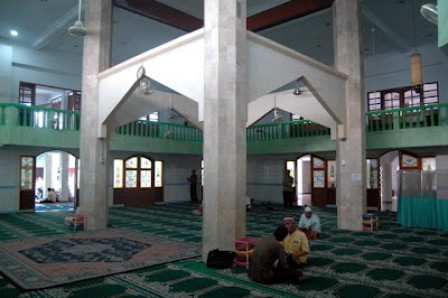Al Atiq Mosque, The Glory Legacy of Sultan Agung Tirtayasa
Reported by Yance Wiratman | Translated by Anisah Mardhatilla
Located in concealed position with a simple architecture makes Al-Atiq mosque is escaped from public attention. Behind its simple architecture, this mosque has a strong influence on the development of the Islam spread in the city. The mosque was also often to be a residents and Jayakarta troops shelter during the fight against VOC.
The founder of this mosque is Sultan Ageng Tirtayasa troops who were fighting against the VOC. Formerly, this mosque was built as a sultan resting place
There is nothing special about this mosque located at the center of a settlement and away from the major roads. Its hidden location from the crowd makes this mosque is not well known among the general public. The mosque is located on Jalan Masjid I No. 3, Kampung Melayu Besar Urban Village, Tebet Sub-District, South Jakarta.
Chairman of Takmir Al Atiq mosque, H Ichwan Rasidi admitted that no one knows for sure exactly when this mosque was built. The elders of the village and treatises that exist in this mosque believed that the it was founded in 1632 AD or 1053 H. Al Atiq name then was given by Jakarta Governor Ali Sadikin in the 1970s. Literally, Al Atiq means the oldest.
Construction of the mosque is expected to coincide with the construction of mosque in Banten and Karang Ampel, Central Java that was built because of Sultan Maulana Hasanuddin role.
"The founder of this mosque is Sultan Ageng Tirtayasa troops who were fighting against the VOC. Formerly, this mosque was built as a sultan resting place," told Ichwan.
The mosque is located right on Ciliwung River bank which also strengthens indication of the truth of the story. According to him, in ancient time, the troops’ movement always took advantages of the river that serves as a source of transportation or drinking for the troops.
At present time, the physical form of the mosque has undergone several changes due to restoration reason. The pillar in the middle of the mosque was made of teak wood, and now it has been replaced with a concrete layered ceramic/marble.
The change also carried out to the building of the mosque, which is built into a modern two-floor building, while the original decorations of the mosque has been submitted to the Jakarta History Museum.
However, the restoration is not completely done to all parts of the mosque. Some components that are still maintained is a trident pointing towards Qibla which is located at the top of minaret. The shape of the minaret is still the same as when it was first built, that is in the form of a pyramid.
Prior to restoration, there are two tombs of the first mosque caretakers. The tombs that are located right next to the pulpit or the place for imam are not known for their names. However, after the restoration, both tombs were moved.
This mosque also keeps a mystical interesting story that is the existence of magic stand located in the pulpit of the mosque. The stick is an heirloom mosque heritage. Reportedly, the powerful stick was used to cure disease through blended concoction of wood scrapes from the stick. Now, scraping that wooden stick has been banned by mosque caretaker.


